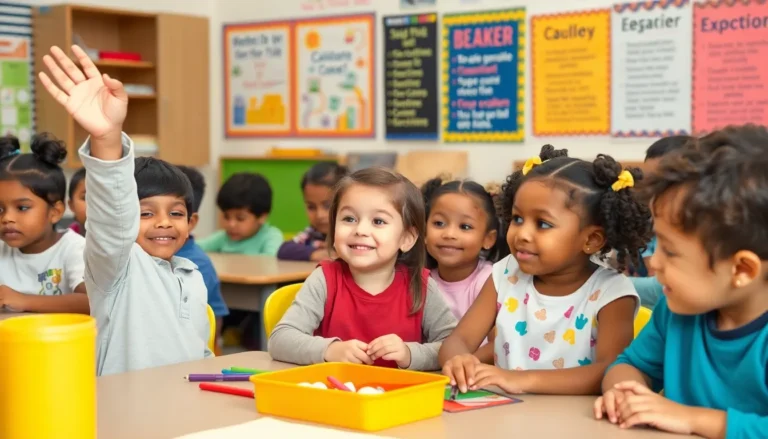Table of Contents
ToggleFinding fun and engaging activities for elementary kids can feel like searching for a unicorn in a haystack. With endless energy and boundless curiosity, kids need more than just a screen to keep them entertained. They crave experiences that spark their imagination and creativity while sneaking in a little learning on the side.
Importance of Activities for Elementary Kids
Engaging in activities plays a crucial role in a child’s development. Activities foster physical health by promoting exercise and movement, essential for strong bodies. Social skills benefit significantly from group activities, allowing children to learn cooperation and communication.
Cognitive development occurs through various hands-on experiences, enhancing problem-solving and critical thinking abilities. Creative activities like art and music encourage self-expression, nurturing emotional growth and resilience. Varied activities help maintain a balance, preventing boredom and promoting engagement.
Opportunities for learning outside the classroom contribute to a child’s holistic education. Exploring nature or participating in community service cultivates a sense of responsibility and environmental awareness. Balanced exposure to structured and unstructured activities aids in developing well-rounded individuals.
Interactive activities stimulate curiosity and motivate exploration. When kids engage in fun learning experiences, they develop a love of knowledge that lasts a lifetime. It’s clear that diverse activities significantly contribute to a joyful and enriching childhood. Prioritizing these experiences sets the foundation for lifelong learning and success.
Types of Activities for Elementary Kids
Finding suitable activities for elementary kids involves a variety of options designed to engage and stimulate their minds and bodies. These include indoor, outdoor, and educational activities that cater to different interests and learning styles.
Indoor Activities
Indoor activities provide a great way for kids to explore creativity while being safe. Crafting projects like painting or making collages engage their imagination and fine motor skills. Board games encourage critical thinking and teamwork as children work together. Science experiments can be both fun and educational, allowing kids to observe reactions and learn scientific concepts. Reading challenges foster a love for literature, while interactive storytelling enhances their verbal skills. Each of these activities contributes to a well-rounded experience, promoting cognitive and social development.
Outdoor Activities
Outdoor activities encourage kids to stay active and connect with nature. Group games like tag or basketball promote teamwork and physical fitness by incorporating exercise into playtime. Nature walks allow kids to explore their surroundings while learning about local flora and fauna. Scavenger hunts combine adventure with problem-solving, making it exciting to discover various items. Gardening teaches responsibility and the science of plant growth while nurturing a sense of achievement. These activities not only enhance physical health but also build social bonds among peers.
Educational Activities
Educational activities enrich learning experiences outside the typical classroom environment. Experimenting with building blocks enhances spatial reasoning and engineering skills. Coding games introduce children to basic programming concepts in an engaging manner. Community service projects teach empathy and social responsibility, allowing kids to make a positive impact. Language learning apps offer interactive gameplay that supports language acquisition. Each educational activity promotes critical thinking while making learning enjoyable and relevant.
Benefits of Engaging Activities
Engaging activities offer numerous benefits for elementary kids, supporting their growth in various domains.
Physical Development
Physical development significantly improves through engaging activities. Movement-based experiences help enhance coordination and balance. Activities like running and climbing foster agility and overall fitness. Regular participation in diverse exercises maintains healthy weight and promotes cardiovascular health. Parks and playgrounds contribute to a child’s energy expenditure while encouraging active play. Incorporating outdoor games, such as tag or soccer, provides fun opportunities for movement and physical challenges. As children enjoy these activities, they build strength and develop motor skills essential for lifelong health.
Social Skills Enhancement
Engaging activities enhance social skills effectively. Participation in group settings allows children to navigate friendships and interactions. Playing team sports teaches cooperation and communication while fostering a sense of belonging. Group projects and collaborative games encourage turn-taking and sharing, essential traits in life. Engaging with peers during these activities helps build trust and empathy, creating a more inclusive environment. Observing and learning from others during playtime forms connections that support emotional intelligence. Strong social abilities cultivated through these experiences enable children to navigate relationships both now and in the future.
Cognitive Growth
Cognitive growth accelerates through hands-on experiences. Activities like puzzles and problem-solving games stimulate critical thinking skills. Engaging in arts and crafts promotes creativity while enhancing spatial reasoning. Group projects aid in collaboration and expose children to diverse perspectives, enriching their understanding. Learning through exploration encourages curiosity and a desire for knowledge. These varied experiences provide meaningful contexts for acquiring skills such as literacy and numeracy. Children thrive in environments that challenge their minds, leading to improved academic performance and long-term cognitive development.
Tips for Parents and Educators
Encouraging participation stands at the forefront of engaging elementary kids. Parents and educators should create an inviting environment that promotes exploration. Establishing a routine allows children to anticipate enjoyable activities. Setting clear expectations fosters a sense of security, making kids more willing to try new experiences.
Incorporating variety remains crucial for maintaining engagement. Mixing different types of indoor and outdoor activities promotes excitement. Organizing themed days, such as science day or art day, helps focus interest while diversifying learning options. Providing opportunities for peer collaboration enhances social skills and inspires creativity through shared experiences.
Assigning roles during group activities offers responsibility, which builds confidence in individual capabilities. Demonstrating enthusiasm while participating alongside children increases their motivation. Including rewards for achievements, even small ones, encourages persistence and a positive attitude towards learning.
Utilizing community resources enhances outdoor explorations. Visiting local parks and nature centers broadens children’s understanding of their environment. Connecting with local experts or volunteers for specialized activities introduces new concepts in a fun way. Creating an outdoor scavenger hunt involves critical thinking while allowing kids to appreciate nature.
Moreover, integrating educational components into playtime reinforces learning. Utilizing board games that require strategy and problem-solving skills promotes cognitive growth. Reading together fosters language acquisition and strengthens emotional bonds. Combining movement activities like dance or yoga supports physical health while being enjoyable.
Balancing structured activities with free play cultivates independence and creativity. Allowing children to make choices empowers them and boosts engagement. Analyzing children’s interests can guide the selection of activities, ensuring they remain invested and eager to explore new opportunities.
Engaging elementary kids in diverse activities is crucial for their overall development. These experiences not only keep boredom at bay but also promote physical health social skills and cognitive growth. By providing a mix of indoor outdoor and educational options parents and educators can create an enriching environment that fosters creativity and learning.
Encouraging exploration and collaboration allows children to thrive while building confidence and independence. With the right approach and enthusiasm these activities can spark a lifelong love for learning and help shape well-rounded individuals ready to face the world.





